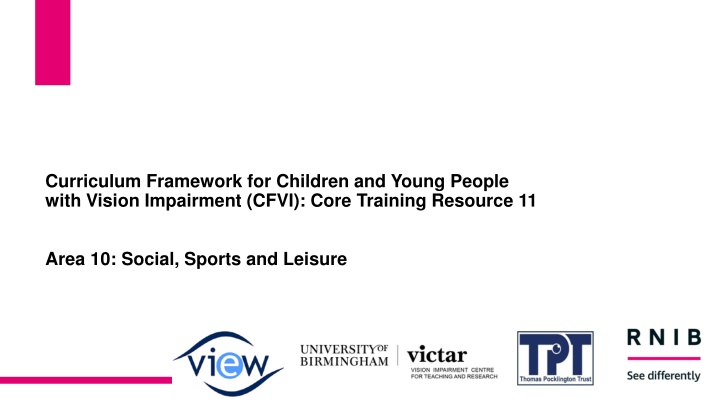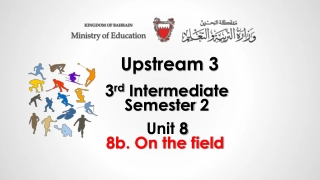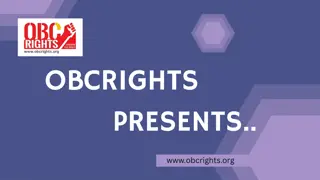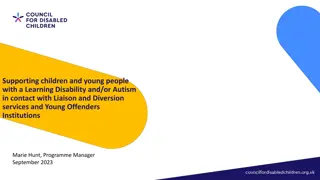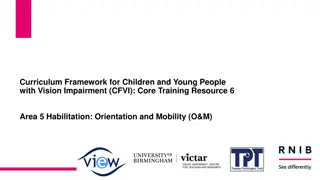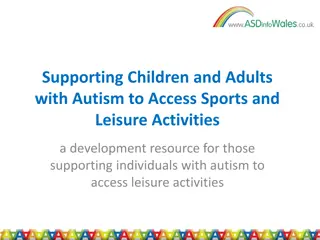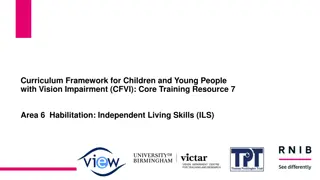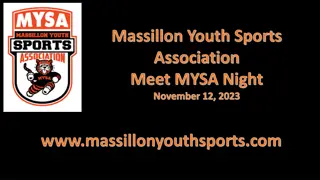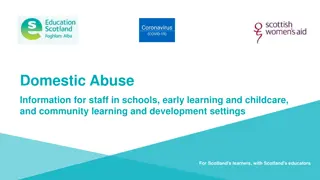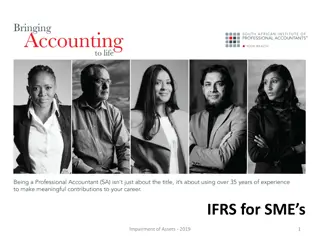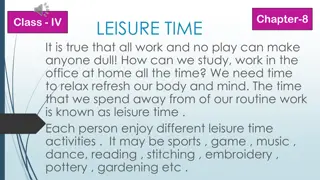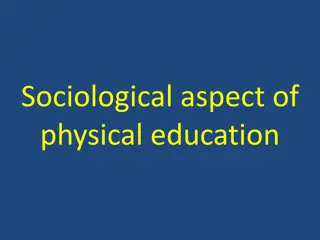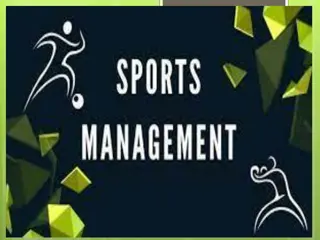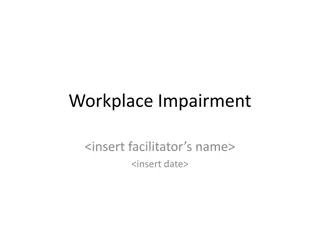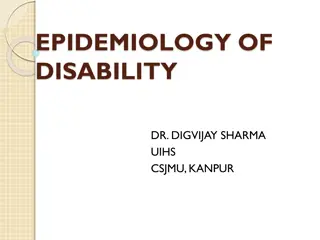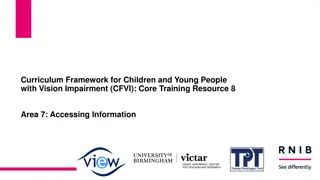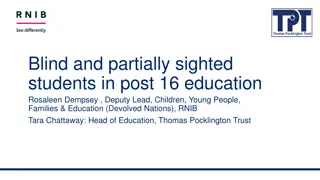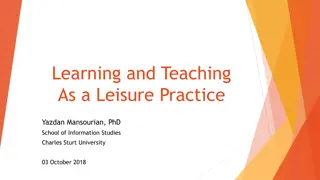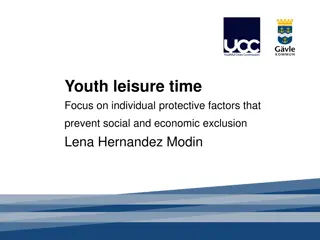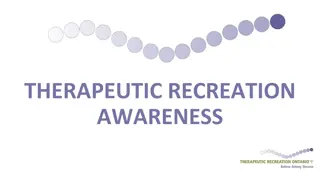Supporting Children and Young People with Vision Impairment in Social, Sports, and Leisure Activities
This curriculum framework focuses on providing training resources to support children and young people with vision impairment in accessing social, sports, and leisure opportunities. The project involves multiple partner organizations and aims to address barriers to participation, outline available activities, and offer valuable resources. It emphasizes the importance of inclusive engagement beyond formal education settings, highlighting opportunities such as Guides/Scouts, swimming clubs, and online hobby-related forums.
Download Presentation

Please find below an Image/Link to download the presentation.
The content on the website is provided AS IS for your information and personal use only. It may not be sold, licensed, or shared on other websites without obtaining consent from the author.If you encounter any issues during the download, it is possible that the publisher has removed the file from their server.
You are allowed to download the files provided on this website for personal or commercial use, subject to the condition that they are used lawfully. All files are the property of their respective owners.
The content on the website is provided AS IS for your information and personal use only. It may not be sold, licensed, or shared on other websites without obtaining consent from the author.
E N D
Presentation Transcript
Curriculum Framework for Children and Young People with Vision Impairment (CFVI): Core Training Resource 11 Area 10: Social, Sports and Leisure
Project Partners There are 4 partner organisations involved in the CFVI project. The production of these training/continuing professional development materials was led by VIEW (The Professional Association for the Vision Impairment Education Workforce), in association with a consultation group of stakeholders working in the field of VI Education.
Curriculum Framework for Children and Young People with Vision Impairment (2022, p.15)
Training Objectives (1) The objectives of this training resource are to: provide an introduction to Area 10 of the CFVI: Social Sports and Leisure examine why a focus on this area is important for learners with vision impairment explore potential barriers that may limit access to these opportunities, and how we can work collaboratively to help reduce these outline a range of social, sports and leisure opportunities that might be available within and beyond formal education for CYPVI provide links to useful resources/websites
Training Objectives (2) Customisable slide if needed (see notes which give examples of training objectives that you could consider, depending on the nature of your presentation).
About this area: Social, Sports and Leisure This area of the framework recognises the importance of supporting children and young people with vision impairment to access and participate in a range of social, sport and leisure opportunities. These opportunities are normally community-based activities and are traditionally offered outside of formal education. The activities may be in a physical location or take place virtually. Examples include: Guides/Scouts, after school events, swimming club, youth club, ballet classes, online chat room in connection with a child s hobby/interests etc.
Identifying potential barriers to access (1) Situation A five year old girl without a vision impairment watching a junior league Saturday morning football match in the local park with her family. The child s older sister is playing as a defender in one of the teams. What does vision tell the child in this situation? that colour tops each team is wearing the lines used to mark the pitch what additional clothing players have on for the weather conditions the colour, shape and size of the football how the players are positioned on the pitch where the match officials are positioned during the match where the crowd is positioned during the match who blows the whistle and shows the red/yellow cards ?
Identifying potential barriers to access and participation (2) Situation Inclusive strategies to reduce potential barriers to access/participation ? A five year old girl with a vision impairment which limits her distance vision is watching a junior league Saturday morning football match in the local park with her family. The child s older sister is playing as a defender in one of the teams.
Identifying potential barriers to access and participation (3) Situation Inclusive strategies to reduce potential barriers to access/participation ? Add here
Why a focus on this area is important Children and young people with vision impairment should have the same opportunities to access and participate in a range of social, sport and leisure activities of their choice. Without appropriate support a vision impairment can reduce these opportunities. We cannot take for granted that CYPVI will know what a given activity is/entails without appropriate experience of it. The required support, intervention approaches and potential opportunities for participation will depend on individual circumstances and may be broader than that drawn upon in an educational setting. The approaches will involve working collaboratively with a wide range of people including family members and professionals/volunteers beyond education.
Examples of targeted intervention approaches for Area 10 listed in CFVI to reduce barriers (1) Accessing family groups, such as baby and toddler groups in the community. Providing opportunities for interaction with others with vision impairment (e.g. family groups, transition days, social events). Awareness of national charities and organisations supporting leisure and sporting opportunities for children and young people with vision impairment, including mentoring opportunities. Accessing enrichment opportunities, such as volunteering and community gardening. Accessing community groups, such as youth clubs.
Examples of targeted intervention approaches for Area 10 listed in CFVI to reduce barriers (2) Participating in religious activities. Support for residential experiences within the school context. Knowing how to get involved in social, sport and leisure activities and finding out what is available. Accessing sports, including competitive sports, providing access to adapted sports activities where the young person can fully participate and work towards competing / higher level skills if they wish. Accessing music, including learning instruments and playing in musical ensembles
Examples of targeted intervention approaches for Area 10 listed in CFVI to reduce barriers (3) Building skills and independence to enable young people to build and sustain positive friendships. Meeting up with friends in age appropriate settings. Accessing online communities, including keeping safe online. Accessing social venues including restaurants, cafes, bars, clubs, theatres, and cinemas.
Why a focus on this area is important for (name of child/young person); what interventions are in place? Details of child/young person s vision impairment How reduced vision influences their access to and participation in a given social/sports/leisure activity What interventions are in place to promote access and participation in activities? What are the envisaged outcomes? Who delivers/works on these outcomes?
Summing up Given the activities within this area will normally take place outside of traditional educational settings, distinctive types of targeted intervention approaches will be required. These approaches should be developed in close collaboration with the child/young person, their family members and those professionals involved in supporting a given activity. The physical, social and self-advocacy skills that CYPVI learn at school and college should equip them to navigate a wide range of mainstream social, sports and leisure environments, including where these are not yet actively inclusive. A wide range of resources are available to help: see Bookshare Hub
What resources are available The Bookshare Hub hosting resources to support the delivery of the CFVI is available from RNIB (External) Of particular relevance to this area is Social Sports and Leisure category of the CFVI Resource Hub The CFVI provides a list of targeted intervention approaches (page 32): Curriculum Framework for Children and Young People with Vision Impairment | RNIB
References Hewett, R., Douglas, G., McLinden, M., James, L., Brydon, G., Chattaway, T.,Cobb, R., Keil, S., Raisanen, S., Sutherland, C., Taylor, J., (2022) Curriculum Framework for Children and young People with Vision Impairment[CFVI]: Defining specialist skills development and best practice support to promote equity, inclusion and personal agency. RNIB
